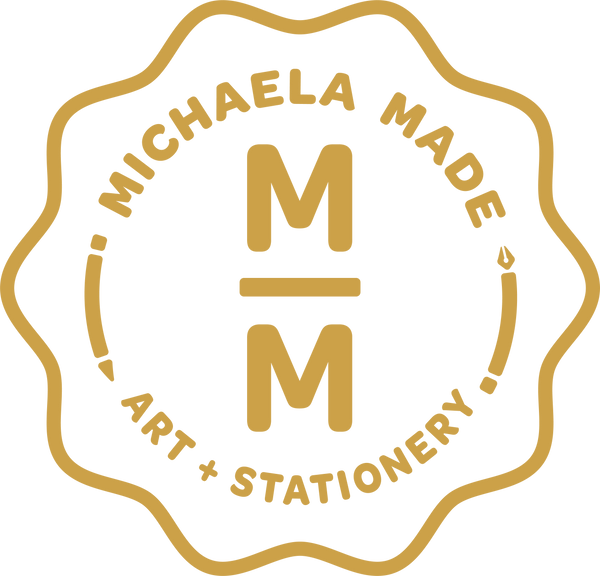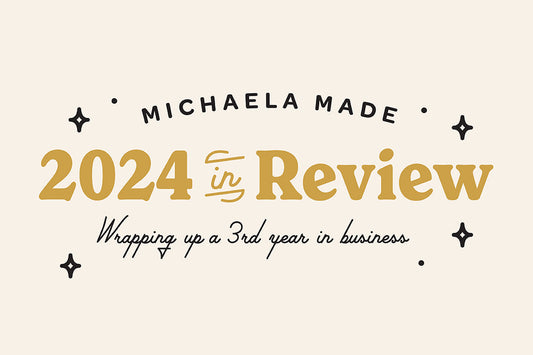My AAPI Story
Learn more about my art journey & origins as an AAPI artist of Michaela Made!
✨ Hello! ✨
I’m a Graphic Designer & Illustrator in Dallas, Texas. Here's the "longer version" of my bio. I wanted to take some space to share my story and how I got to Michaela Made here on the internet. You can watch my video about my journey below!
In honor of AAPI Heritage Month, I wanted to share a little bit more about my story with you guys. So I was actually born in China and I was adopted when I was about one year old and growing up I pretty much like had a lot of creative interests, including reading a lot of graphic novels, playing lots of Pokemon, and weaving a lot of friendship bracelets, which I actually have a little kit that I had growing up, which had like all these little, um, organized, like focused, oh yeah, like kind of unfinished friendship bracelets here.
Early Art Interests
That was a lot of really cool things that I actually got to do, and fun fact, I even started a small business at the time, um, with my fourth grade class with these friendship bracelets, and we called it Leave It To Me First. So you could say I kind of had like some sort of entrepreneurial spirit growing up, which was really cool, and I really appreciate Mr. Preston's fourth grade class for supporting my little endeavors and During that time, I, like, you know, in grade school, I definitely drew a lot of, like, little fan art and stuff from, like, the video games I was playing, or nature that I saw on my trips, and so it was very rudimentary, um, but I definitely expressed a, like, a interest in art.
I just didn't really know any paths, um, growing up. Neither of my parents. were artists. Um, they both worked in kind of technical fields. And so it was, um, definitely a mystery to me and like how I could potentially become an artist. I didn't have a huge connection to my Asian heritage. I think I saw some movies at the time, including Mulan, Big Bird Goes to China.
And I even got to go to China in 2005, where I learned to make origami paper stars and cranes. And I felt like a really great connection, um, to that work. I was Chinese, I was also involved in orchestra, which, and I played the viola, which felt very un Asian, like if you like equate the most Asian instrument was definitely to play the violin.
And so I still felt a little off playing the viola, but I still felt also connected by doing that. And so I also got to meet a lot of other Asian American kids through my school. student organization of Orchestra, and um, a lot of them remain friends, um, to this day, including my husband, who I met in Orchestra.
I would definitely say my artistic journey throughout grade school, I took a lot of art lessons, and by high school, I ended up taking advanced art classes, and really started to kind of take my art seriously, um, amidst all the other student I definitely wanted to include art in my coursework. A lot of my art starting out was a lot of fan art and I started to develop my style um to be very like hyper realistic because at the time I was very much a perfectionist if not.
still now, but I think a lot of the work that I started doing, um, definitely leaned into that perfectionism and trying to get everything exactly perfect, exactly what I saw on the piece of paper. And so that was kind of what you will see in a lot of my early work. And by the time I got to college, I feel like I still, even though my parents were white, I still felt like I had the expectations to make a living with whatever profession I was doing.
So even though they were fairly supportive of me going to art school, they still were very much like, don't be a starting artist kind of situation. So, um, I definitely was thinking, okay, I think I'm going to just go in to art school at with double majoring and art and business. And so that was what I initially started doing. I went in with like a studio art major and then thought I would major in business as well. Once I started my major, my first semester my advisor actually recommended me to look into what they call the communication design program or graphic design program within the art college and I knew a couple classmates who were in it, but I was just like, I don't know.
I'm not gonna like apply to this. And so I wasn't really sure if that was for me, but he gave me the chance to, uh, take a class to where I could apply for the program and see if I liked it. And I took the program and I actually really enjoyed it. And so that kind of put me on the path to graphic design.
And so a lot of my work started. Um, developing and I ended up doing a graphic design major with a minor in business. And so that really simplified my art education really early on. Um, and I definitely like, you know, dove headfirst into graphic design in. So after college, I. I really still felt a little out of place.
I went to school in Lubbock, Texas, and so that was very much a white dominated demographic. There were still a few minorities, you know, um, interspersed throughout the college, but I still felt very much like a banana, um, as some people would call it, where I'm, like, yellow on the outside, white on the inside.
And I think navigating that, you know, going into my professional career always felt a little, um, like people just kind of assumed that I was raised Asian, um, even if I had like an American accent. And that I could speak Mandarin and neither was the case. I have felt a little out of place and even like a fraud for, um, looking Asian but not having any actual, you know, cultural experience with growing up in an Asian culture.
It's always felt a little off and out of place, um, for me. It's an adopted child, you know, who's also, and so as you can see, a lot of my work in kind of my free time and stuff, I really started to try to connect to my roots through food and Asian imagery or the things that, you know, I grew up, um, watching as a child, like a lot of Hiyao Miyazaki.
And that was really important for me to start like channeling these cultural roots into my artwork. I would definitely say probably one of the biggest challenges that I've faced, um, being an Asian American and having a lot of Asian influences in my artwork. I think the biggest one is using Asian characters in my artwork and I've only recently started using this and I have just been terrified that someone is going to, um, call me out and just say like, you did this wrong.
You wrote these Chinese characters or these Japanese characters wrong, you aren't even Japanese, you aren't even, like, Chinese. Why do you think you should be able to include this in your work? And that's extremely terrifying. And so I work really hard to do my research and make sure that my work is respectful to any of the culture.
like Asian cultures that I'm drawing my work from. My husband is Hispanic, but he is actually the one who's learning Japanese. And so I tend to consult with him a lot because he's learning the characters, he's learning about the culture a lot more in depth than I am. We definitely work together to make sure that we're respecting and doing our research for that kind of stuff.
I think like grappling with what I call, you know, Asian imposter syndrome is a real thing to me and many of my Asian American kids who know both cultures and want to learn more and respect their roots. And so I feel like it's hard to feel okay expressing my experience. But I know, also know I'm not alone.
That's kind of where I wanted to end was like, we all have a story. We're all here existing in our own experiences, um, in our own upbringings. But I feel like everyone's story is so important to share, including my own. And so I really hope that you guys enjoyed deep dive into more of my history and my story.
And so, if you guys really enjoyed this, please give it a like. And subscribe to my Youtube Channel. I'm hoping to share more about my art journey and process videos behind my work. You can also subscribe to my newsletter here!
Chat soon, and thanks for being here!




